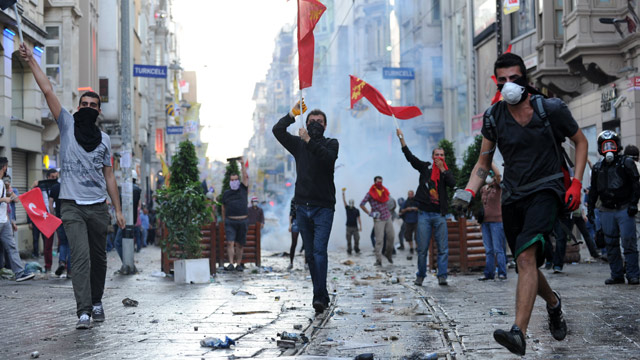On June 1st, in solidarity with the massive resistance in Turkey which began six days ago, Liberate the Land activists in San Francisco marched to a park space known as “Hayes Valley Farm” and began an occupation. The piece of land is scheduled to be turned into condominiums, a development project which the protestors plan to stop. Not only are they physically holding the space with their bodies and multiple treesits, the group is also planting a “Free Farm” for the community, sharing regular meals, and holding community-building and permaculture workshops.
Participants have renamed the space “Gezi Gardens” in solidarity with the current rebellion in Turkey, which began with the occupation of Gezi park in Istanbul. Protesters in Istanbul began occupying Gezi park when developers started ripping up the trees to make way for a shopping mall. The insane police response sparked an uprising that has swept the country. There have been other solidarity demonstrations all over the world, including the reoccupation of Zuccotti park in New York City, the original home of Occupy Wall Street.
Liberate the Land plans to occupy indefinitely, and has released a statement asking others to join them:
Liberate the Land invites everyone to join this network in the days following today’s liberation, to plant food, create and promote permaculture, host and attend workshops, teach and take classes, play and enjoy music, build, gather, experiment, play, learn, and be together. A vibrant community of plants and people are living on this land as of this first of June rather than the first layers of concrete foundation for condominiums. We invite our neighbors in Hayes Valley to join us in open dialogue to further decide what Gezi Gardens will become.
Liberate the Land is bringing into dialogue the concept of common space, a classification of space that goes outside of the dichotomy of private and public and instead places itself as the commons. The commons exist as the spaces owned and operated neither by governments and states, nor corporations and private individuals. Instead, the commons are owned, or stewarded, by all people, with an understanding that the gifts of the earth are for all to enjoy and that people need land bases for growing food, harvesting medicinal plans, maintaining healthy forests for building materials and firewood, wildcrafting plants for fabrics, and hosting wildlife habitat.
Read the rest of the statement here, and follow @LiberateLand on twitter for more updates on Gezi Gardens








